BY ISADORA ZUCKER ’25
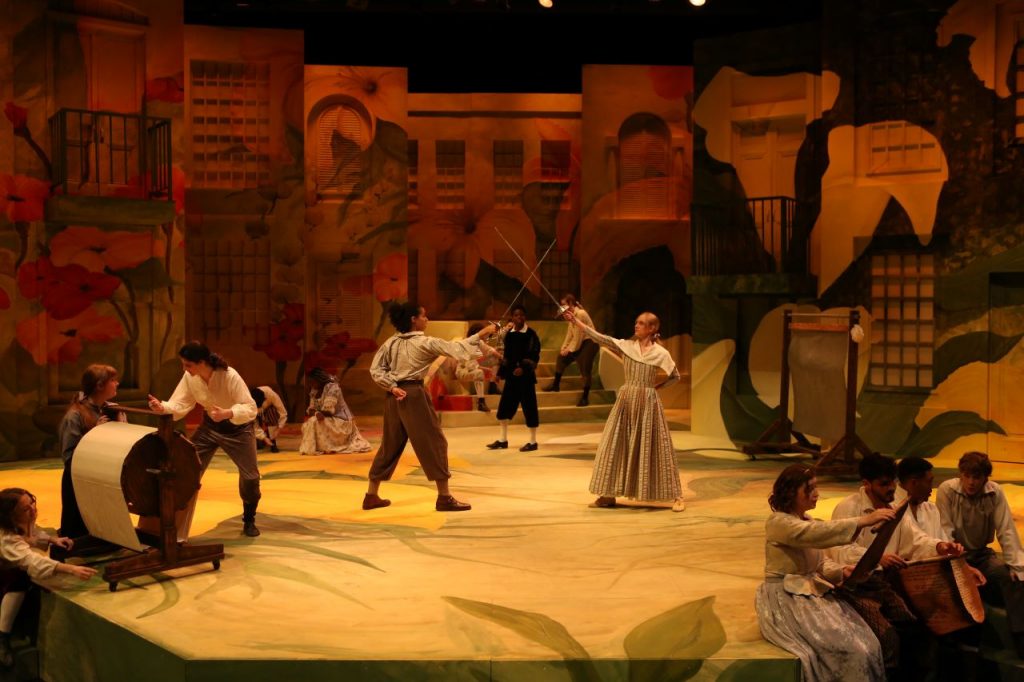
Picture the warm summer of the Spanish countryside; flowers cascade over the walls and floors of a vivid landscape as the strumming of classical guitar plays in the background. This is the setting for Ana Caro’s The Courage To Right a Woman’s Wrongs, Skidmore Theater’s Fall 2023 Mainstage production. Directed by Dr. Lisa Jackson-Schebetta, this show was a beautiful exploration of love, revenge, and gender.
The show opens with the entire ensemble onstage. They are preparing for the feat of a show to come and establish the production’s play-within-a-play context. Flower petals raining from the sky signal the transition into the play, which opens with a fearsome storm in the mountains. We are introduced to the Countess Estela (Chavon Patterson ‘24), and her cousin Lisarda (Nina Renkert ‘25), who have been caught in the storm while hunting. A group of bandits find and capture the two women, who are then saved by the dashing Don Juan (Javier Soto ‘25) and his servant Tomillo (Sofia Fenner ‘25). Once Don Juan successfully defeats the bandits, a noble gentleman named Don Fernando de Ribera (Darren Jackson-Wilkins ‘25), whom Lisarda and Estela know, enters and prepares to defend the two women from Don Juan who he perceives as a threat. As Don Juan begins to share his story with the group, Prince Ludovico (Jordan Gonzales ‘24) enters, and ushers Estela and Lisarda away with him back to Brussels, their home city. As Don Fernando and Don Juan continue to talk before joining the others, Don Juan reveals that he abandoned a woman whom he promised to marry back home. Juan expresses shame at his actions but is resolute in his decision. The two continue onwards to Brussels and Don Fernando promises his generous hospitality to Don Juan during his stay in Flanders, a glimpse of Don Fernando’s characteristic selflessness.
As the two men leave, Leanor (Gigi Brown ‘24) enters the stage alongside her servant and valued friend
Ribete (Sophie Kelly ‘25). The pair, both disguised as men, are making their way to Brussels as part of
Leanor’s plan to enact revenge on the man who promised to marry her before disappearing- Don Juan. They enter the city to find Don Fernando, who happens to be Leanor’s brother. Leanor convinces her
brother that she is not Leanor but rather Don Leonardo, a fictional acquaintance of herself who also happens to be Don Fernando’s cousin. Encouraged by Ribete, Leanor creates a compelling story to explain her purpose in coming to Flanders. Don Fernando, feeling emotional over the tales of his family and home city, pledges his loyalty as a friend and “brother” to Leanor by offering to house her and Ribete in the Infanta’s castle where he works. Everything is going according to plan until Don Fernando mentions that Leonor and Ribete will be housed alongside a man named Don Juan. Leanor maintains composure as she listens to her brother talk about Don Juan’s attraction to a countess named Estela. Once Don Fernando leaves, Leonor begins to violently spiral despite Ribete’s best efforts to calm her down. From this point forward, the audience sees a shift in Leanor as her madness grows and her thirst for revenge intensifies, making riskier methods of revenge more appealing to her.

Shortly after, the audience watches the first of various dialogue-free interstitials wherein Ribete meets a fellow servant Flora (Ida Mihok ‘24) at the court. The two exchange shy glances and some oranges, which Ribete tries to juggle but fails at, signaling the beginning of a budding romance between the two servants. Continuing the theme of new romantic beginnings, Estela and Lisarda enter the stage and muse about Estela’s intensifying affection for Don Leonardo, or Leanor’s male persona. Lisarda brings up the other princes who court the countess, but Estela disregards her past feelings toward Don Juan, turns down Don Fernando, and flippantly dismisses Prince Ludovico. Leanor, dressed as Don Leonardo enters and romantically banters with Estela. The witty conversation ends with Estela demanding that Don Leonardo meet her under her balcony window that night.
Shortly after, Prince Ludovico enters seeking advice from Leanor about Estela. Though Ribete warns Leanor to act with caution in seeking revenge, Leonor manipulates the gullible prince anyway to do her bidding. For Estela to reject her love for Don Leonardo, Leonor tells Prince Ludovico that he must go to Estela’s window that night disguised as Don Leonardo, and persuade the countess instead to shift her favors onto the prince. As Leanor and the prince leave to discuss their plan, Tomillo enters and attempts to make small talk with a cautious Ribete, who eventually gets fed up with the other’s antics and storms offstage. In the transition between the scenes, another interstitial occurs with Ribete and Flora exchanging love letters.
Juan enters and is evidently frustrated by Estela’s affection for another man whom he recognizes looks a lot like the Leonor he left back home. The irony of his senitment comes through when he claims that “it is as if Leonor had come from Spain just to get in [his] way.” Soon thereafter, Ribete enters with a letter for Don Juan, written by Leanor but made to look like it was written by Countess Estela. Ribete is concerned about Leonor’s well-being as her conniving increases in boldness, but she continues to follow her master’s orders despite feeling disregarded by Leonor whose safety she only cares for. Upon receiving the letter, Don Juan rejoices under the false premise that Estela has invited him to talk under her balcony that night. Ribete reports back to Leanor, again questioning her plan and pleading with her not to be reckless. The two begin to fight, tense emotions finally getting the better of them, until Ribete angrily turns to leave. Before she exits, Ribete backhandedly calls Leanor “My Lady” rather than the masculine honorific she has been using up to this point when referring to Leonor. Ribete’s sharp words emphasize how much in gravity Leonor’s lie has grown, marking a turning point in the show wherein Leonor’s madness has driven her loved ones away. Once Ribete is gone, Leanor is left alone to deal with the consequences of her actions.
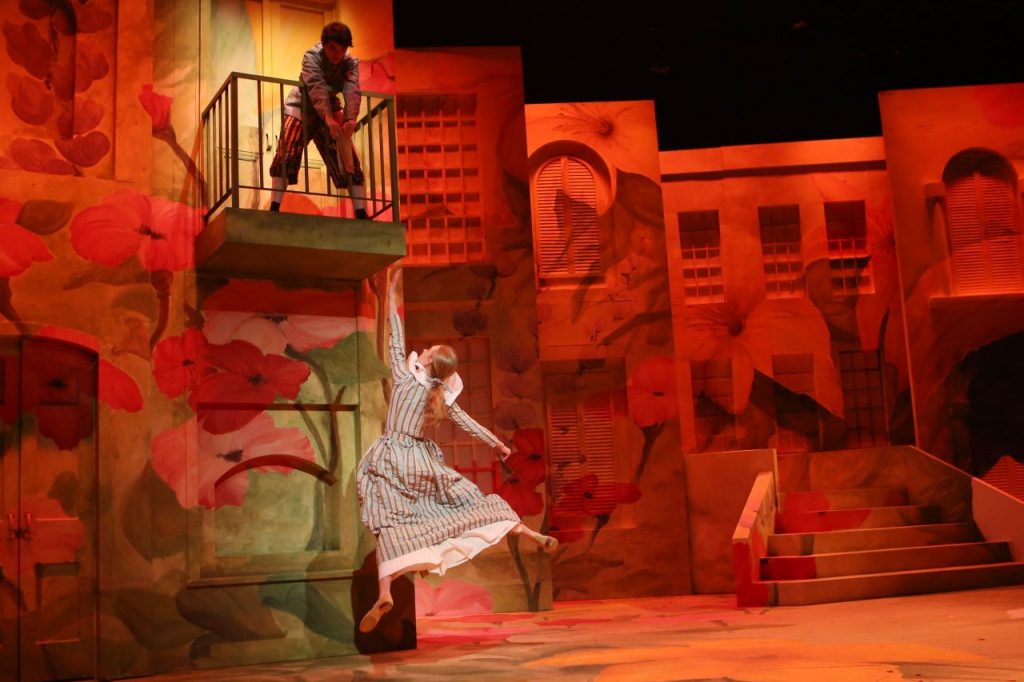
Following Ribete’s departure, Don Juan enters, prompting Leonor to conceal her identity and put her hood on over her head. She confronts Don Juan and provokes him to a duel, though Don Juan is convinced that Leonor has mistaken him for another person. Just as the fight begins to escalate, Prince Ludovico enters and joins Leanor’s side to try and defeat his rival for Estela’s love. In a surprising turn of events, Leanor turns on the prince and claims that she alone needs to settle her grudge with Juan. The prince flees in shock, leaving Leonor with Don Juan to continue what she started. Unsurprisingly, however, Don Juan refuses to fight out of gratitude for being defended. Leonor acquiesces and declares that she will kill Don Juan later. She ends the scene with, “This is enough for now.” A final interstitial with Ribete and Flora stargazing romantically ends Act One.
The second act opens with backlights shining through the windows on stage, casting a warm glow
across the set. Estela and Leanor enter on two separate balconies, with Estela overlooking Prince Ludovico and Leonor overlooking Don Juan; both men are on the ground below. Under the pretense that he is Don Leonardo, Prince Ludovico underlines the ease with which Estela changed her affections from Don Juan to Leonardo, suggesting that perhaps she does the same by giving Prince Ludovico a chance at her desire. Estela rejects this suggestion and declares that she has never and will never have feelings for the prince. On the other side of the stage, Leonor hopes that by pretending to be Estela, she can make Juan believe that the countess of his affections hates him. Leonor reveals to Don Juan that she knows of his “secret” and that could never give such a fickle man her heart. Believing that the woman speaking is Estela, Don Juan is crushed by the discovery, and questions how she could have known about his shameful past. The scene ends with another interstitial, but this time, Ribete is out of sight as Tomillo tries to win Flora’s affection. Instead, he ends up disgusting her and driving her away with his poor hygiene.
After the two servants exit the stage, Don Juan and Don Fernando enter. Being that only Fernando knew of Don Juan’s past, Juan asks Fernando if he was the one who told Estela. Don Fernando denies the accusation and promises Juan that he kept his word, but before the two can talk any further, Lisarda and Estela enter the space. Don Juan, convinced that Estela knows, asks her how she found out about his past. Truthfully, Estela is shocked and informs Juan that she never knew until he admitted to his sins right then and there. She brushes off his queries as a joke and is evidently unfazed by his admission since she does not have any feelings for him. Afterward, Juan and Fernando exit, leaving the two women to speculate about Don Juan’s lover from Seville. Up until this point, the production has made clear that Estela
and Lisarda are some of, if not the, most intelligent characters in the play. Thanks to Dr. Lisa’s direction, the female characters in the show were given the opportunity to showcase their autonomy and intellect, which I appreciated.
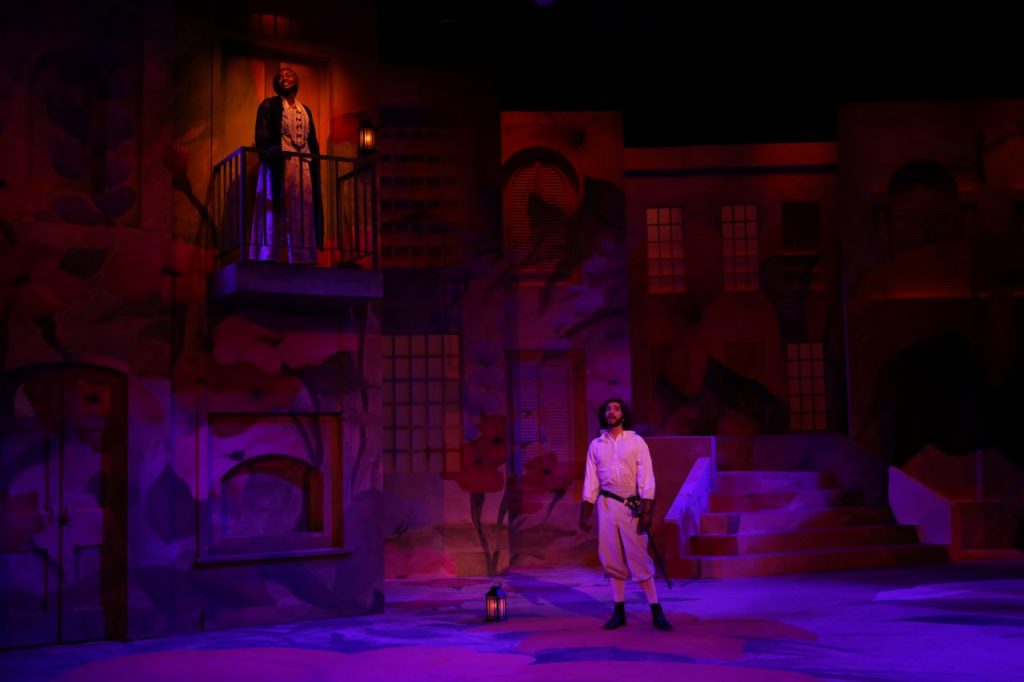
Leanor joins the two women on stage and begins to flirt with Estela in a way that seems to mirror their first exchange in Act One. This time, however, Estela initiates more of the romantic remarks while Leanor dissuades her from pursuing the relationship further. Estela is persistent in her intentions and asks Leonor to meet her in the park that day, before exiting. Don Juan enters shortly thereafter and sees Leonor as Don Leonardo. He pleads with her to stop courting Estela so that he may win her heart once again, which is the final spark that sets Leonor’s full madness ablaze. She tells Don Juan that she, as Don Leonardo, is of no use to him, as she is devoted to another woman and not Estela. Confused as he is, Don Juan listens intently as Leonor recounts how she traveled to Brussels to avenge her lover, who was promised marriage by a dishonest man before abandoning her. At this point, Leanor takes out a portrait of herself and hands it to Don Juan, telling him that the woman in the picture is the one she, Don Leonardo, seeks to marry and avenge. Shocked to see his former lover at the hands of another, Don Juan draws his sword to duel Don Leonardo, saying that he is consumed with rage and a rekindled love for the woman he abandoned. As they begin to duel, Don Fernando enters and breaks up the fight. Don Juan leaves, pledging to finish the duel later.
The next scene begins with Tomillo stumbling onstage, visibly inebriated to a degree far more
intense than what alcohol could induce. He passes out on stage, then is searched and robbed by a
scheming Flora. She reveals she gave Tomillo a drugged chocolate drink to enact her own form of
revenge on him for continuously making unwanted advances toward her. Ribete then enters, saddened
and hurt by Leanor’s actions, and worried that she is accidentally going to self-destruct and get both of
them killed. She sees Tomillo on the ground, and upon realizing he is drunk, disregards him to go find
Leanor.
In the final interstitial, the ensemble prepares themselves for an incoming storm. Don Juan enters and exclaims that his jealousy has only grown, recognizing that only death could bring him resolution. Soon after, Leanor enters, taunting Don Juan and preparing to duel. Ribete finds the two of them with their swords out, and having had her fears confirmed, runs to find help. After Don Juan and Leanor continue to
exchange both verbal and physical blows, Ribete returns with Don Fernando and Prince Ludovico who both jump in to join the fight. Upon their arrival, Leanor reveals the full truth of Don Juan’s past, including
the fact that the woman he promised to marry was none other than Don Fernando’s sister. Blinded by anger and confusion, Don Fernando fails to see a way out of the situation that ensures all of their safety and states that they “must all kill each other” for he “can see no other way out.”
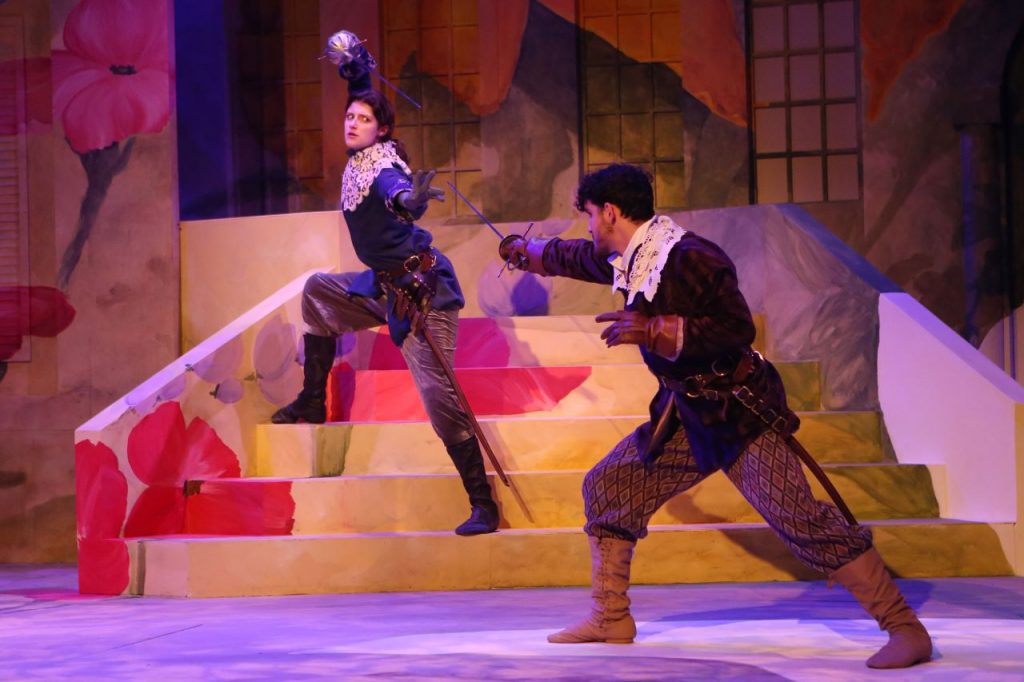
Don Juan continues to lament, questioning why Leanor had forsaken her honor so; he realizes as
he speaks that he would still love Leanor and go back to her without question if she simply hadn’t left him
for another man. Upon hearing this, Leanor stops and confirms with Don Juan of his willingness to repent and take Leonor back. She leaves and tells the others that Leonor will be on her way soon. The entire cast comes on stage as Leanor re-enters, but this time, as herself in a baby blue gown. She explains her lie to the court, explaining that Don Leonardo was truly her the whole time and that Leanor did not dishonor herself and commit to another man. Don Juan, on his knees, proclaims his adoration for her, and the two embrace. Seeing that the man she loves is no longer an option, Estela decides to accept Don Fernando as her husband instead and tells Leonor that they are “sisters”. Prince Ludovico accepts this turn of events and proposes to Lisarda instead, who agrees. Upon seeing everyone get together, Ribete steps forward and publicly asks Flora to be with her. With the permission of Estela, Flora happily accepts Ribete’s proposition. As the show draws to a close, the characters leave the stage, and the play-within-a-play metaplot is referenced once again. The show closes with Leanor, speaking as if the playwright Caro was speaking through her by saying “Its creator, a modest woman, begs you to forgive its faults.”
It is no secret that throughout history, female artists have been discredited and brushed aside in favor of their male counterparts; this is no different when it comes to theater. When imagining a historic theater, many will immediately picture a Shakespearean production somewhere in England, in which all of the actors and many of the audience members are men. However, the practice of theater has always been a way to explore societal norms and break away from more traditional roles, something that was demonstrated especially well during the Spanish Golden Age. Ana Caro de Mallén wrote The Courage To Write a Woman’s Wrongs in the 1620s, during a time of flourishment in the Spanish economy and theater. It was not all that uncommon for women to write plays at this time—Ribete even hints at this in the show, cheekily claiming “Even women want to write poetry, and dare to write plays.” Indeed, many actors and theater company managers at the time in Spain were female. A play centering around a cast of independent, intelligent women may seem out of place for the time period, but in reality, it is a shining testament to some of the more progressive movements happening in 17th-century Spain.
For more information on the historical context of this play, I highly suggest visiting this
website created by production dramaturg Reyn Ricafort (‘25).
The dramaturgy work was particularly important for this production, considering that it was indeed a
historical play. One of the most challenging parts of performing an older show, especially when it is
written in verse, is making sure the messages and themes translate to a modern audience. It was evident that the entire cast and crew put great care into comprehensively understanding the plot and speaking the words with intention. Additionally, I was particularly drawn in by the use of movement and dialogue-free moments to enhance the plot and highlight the deeper meaning of some of the wordier scenes. The use of interstitials throughout the play allowed for greater character development for many of the characters in the show, particularly Ribete and Flora. There was also a recurring theme in which some of the ensemble members performed a choreographed set of movements during Estela and Leonor’s flirtatious exchanges; the movements resembled a game of chess, which visually represented the intelligence and complexity of Leonor and Estela’s rationale during much of the show.
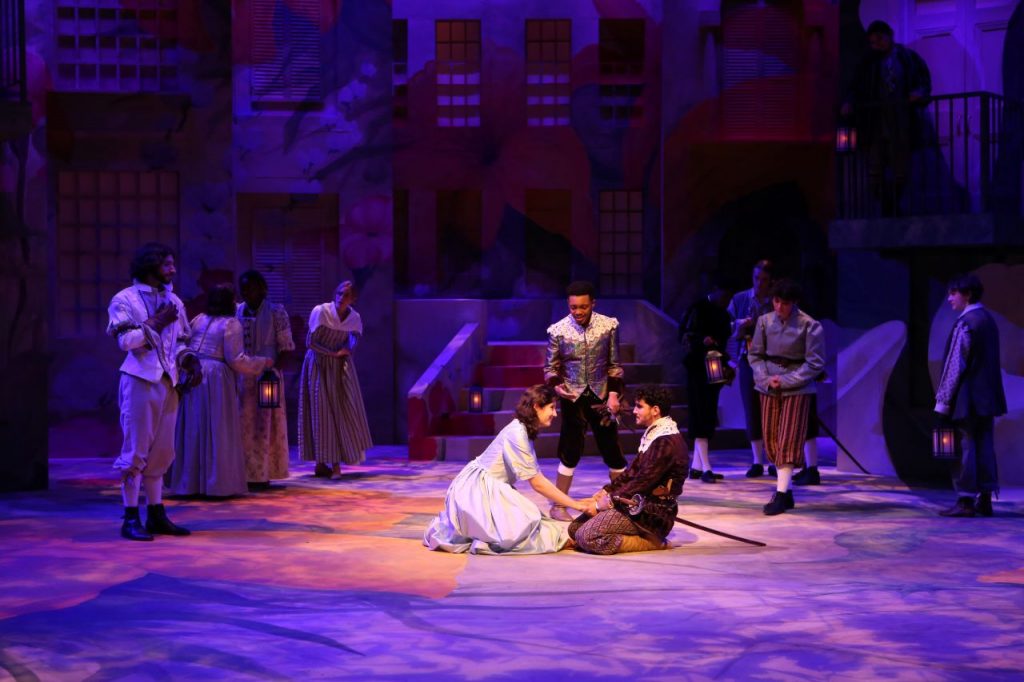
Not only does the verse add an extra layer of understanding to the show, but the exploration of gender within the play is also important to take into account, especially in a modern context; in particular, the characters of Leanor and Ribete demonstrated an interesting fluidity regarding gender expression. In the original script, Ribete is written as a cisgender man, which adds an oddly sexist undertone to the character’s role in the show. Especially in this production, Ribete was often seen as a sort of “voice of reason” character, trying to make sure Leanor’s so-called female madness was kept in check. When Ribete is portrayed as a man, their role in the story changes from a well-intentioned friend to a reluctant man dealing with his female companion’s wild moods. It’s also important to point out that despite Ribete
being portrayed as a non-male, Ribete never reveals themselves as a “woman” much like Leonor does at the end, suggesting that Ribete’s gender identity may not be as set in stone as initially thought.
Leanor’s exploration of gender is more directly written into the script. Early in the show, she
proclaims “You are mistaken, Ribete, if you think I am a woman. The wrong done to me changed me.”
which could easily be interpreted as a statement declaring herself to be transgender. However, at the end
of the show, Leanor does end up presenting as a woman again and seems to be content to do so. When
talking about Leanor’s character arc in the show, it is again important to consider the historical context;
despite the freedom in gender expression seen in Spain at the time, the idea that a play could center
around a noblewoman who goes against gender norms and does not end up with a man was still
scandalous and would have resulted in consequences for the playwright. Despite Leanor’s inherent
queerness, she ultimately presents as a woman; this does not deny the underlying gender fluidity she
experiences, but rather is a commentary on the way society has pressured gender non-conforming
individuals to stay within stricter gender roles. As a modern audience, we have more room for nuance
whence discussing Leanor and her gender, which I think enhances the queer subtext throughout the play.
The Courage to Right a Woman’s Wrongs was a beautiful show, full of hilarious moments and
touching sincerity. The entire team should be proud of their work, as it truly shone through in the final
piece.
Photos by Sue Kessler
***
Isadora Zucker ’25 is a staff writer for the Skidmore Theater Living Newsletter
